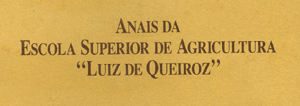Resumo em Português:
De uma plantação de almeirão (Chicorium intybus c.v. Folha Larga) foram coletadas 30 plantas com 4 repetições aos 25, 35, 45 e 55 dias após a emergência. O material coletado foi dividido em folhas e raízes e analisados por N, P, K, Ca, Mg, S, B, Cu, Fe, Mn, Zn, pelos métodos convencionais de laboratório. O elemento extraído em maior quantidade foi o nitrogênio, seguido de potássio, cálcio, fósforo, magnésio e enxofre. Dentre os micronutrientes o elemento extraído em maiores quantidades foi o ferro, seguido do manganês, zinco, boro e finalmente pelo cobre. Estabelece-se o nível crítico para os nutrientes os seguintes valores: 4,39% N, 0,47% P, 2,93 K, 1,00 % Ca, 0,35% Mg, 0,20% S, 59 ppm B, 15 ppm Cu, 2,926 ppm Fe, 117 ppm Mn e 80 ppm Zn. A extração total por folhas e raízes foi de 5.000 plantas/100 m² e de 92,3 g N, 13,3 g P, 83,2 g K, 28,8 g Ca, 8,6 g Mg, 5,45 g S, 154 mg B, 38 mg Cu, 7,979 mg Fe, 301 mg Mn e 214 mg Zn.
Resumo em Inglês:
Twenty five, 35, 45 and 55-day old chicory plants from a Folha Larga c.v. crop were collected and separeted into leaves and roots, and then analysed for N, P, K, Ca, Mg, S, B, Cu, Fe, Mn and Zn by lab conventional methods. The dry matter content was founol to increase up to the time plants were 45 days old. The total nutrient contents in 5.000 plants/100 m² at 45 days were: 92.3 g N, 13.3 g P, 83.2 g Ca, 8.6 g Mg, 5.4 g S, 154 mg B, 38 mg Cu, 7.979 mg Fe, 301 mg Mn and 214 mg Zn. The nutrient levels in leaves of 45-day old plants were: 4.39% N, 0,47% P, 2.93% K, 1.00% Ca, 0.35% Mg, 0.20% S, 59 ppm B, 15 ppm Cu, 2.926 ppm Fe, 117 ppm Mn and 80 ppm Zn.
